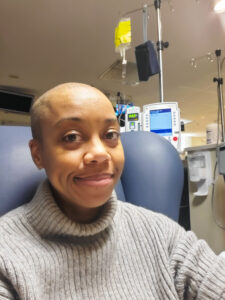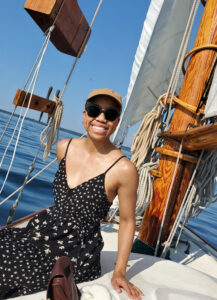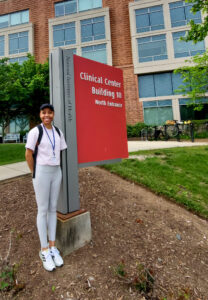Nola Johnson Strives to Raise Awareness Through Fundraisers

Nola Johnson, who is turning 40 this year, was diagnosed with Takayasu in January 2023. Like most people, before she was diagnosed, she didn’t know anything about vasculitis.
What she learned was that she had been having symptoms of vasculitis for more than five years and that most of her doctors had little knowledge of her rare disease. What was most disappointing to Nola was that her previous doctors weren’t curious enough to pursue her symptoms or concerning lab results. That changed once she was in an emergency and happened to land at Duke University, a teaching hospital.
The emergency began during a flight while Nola was returning home from vacation. She was having a hard time breathing and sweating profusely while walking through the airport and then experienced a headache upon takeoff.
“Shortly after I got off the plane, I drove to the ER. I thought I would be home that night,” she said. “It turned out to be four days later.”
A CT scan revealed an aneurysm in her aorta. She was transferred to Duke’s main campus and prepped for surgery.
“I had no awareness even about the aorta, the size of it, or how it worked,” Nola said. “All of it was brand new information for me.”
The radiology team did additional scans confirming that Nola’s aneurysm was stable, so surgery would not be necessary. They did however notice inflammation throughout her body, and made note that it was most likely Takayasu. They recommended Nola immediately start seeing a rheumatologist for a formal diagnosis and treatment plan.
Raising Awareness
Nola quickly began learning about vasculitis and by May of 2023, she started a fundraising and awareness campaign for Vasculitis Awareness Month. She kept it going through June and into July for her 38th birthday, with a goal of raising $3,800.
“A lot came with launching the fundraiser and navigating the rare disease space,” she said. “I was trying to find ways to share what was going on with me. Trying to share signs, symptoms and the different forms of Vasculitis.”
She wanted to make sure more people knew about vasculitis and were equipped to recognize the symptoms – that included doctors.
This year she is turning 40 and she has set a goal to raise $10,000. She had raised more than $8,000 at the start of Vasculitis Awareness Month.
“I have given to fundraisers, but hadn’t hosted my own until being diagnosed with vasculitis,” she said. “I decided I would do the first one because I wanted to talk about vasculitis, but it was important to me to keep the goal manageable. This year, I said ‘go for something you think you might not be able to do.’
The success is more about the advocacy. I have been so impressed by the 52 people who have donated so far and not the dollar amount. I want people to understand the disease, what it is. That is the driving force behind this and now 52 more people can say they’re aware of vasculitis. I hope that number continues to grow as we get closer to July.”
She’s not stopping before her birthday, even though she may make her $10,000 goal this month. She credits her parents for helping to spread awareness during this campaign. When she was first diagnosed, she said, they were reluctant to share.
“One of the reasons I’ve done so well is because my parents have been telling people,” Nola said. “I asked them to share what has been going on for the past two years and to help raise awareness by telling their friends.”
Impacting Diagnoses
She hopes her donations will help fund more research and lead to earlier diagnoses and greater awareness.
“I would love to impact early diagnosis,” she said. “Being diagnosed with something that no one says they can fix is scary. I always worry when talks about surgery come up, because if we can’t figure out how to turn off the inflammation, surgery feels more like a band-aid than a solution. Ultimately, I would love an environment where someone isn’t living in the unknown like I am.”

The fundraiser has also offered her connections to her community, as well as to other vasculitis patients.
“It has been lovely and I have been very touched,” she said. “I have people telling me they are aware of something they didn’t know before. I have met so many people who have a form of vasculitis, or know a friend or family member. That has been amazing, because I don’t feel so alone in my journey.”
When she was first told she had vasculitis, she asked folks in the ER if there were support groups or therapists for vasculitis patients, services similar to what you might find after a cancer diagnosis
“They told me no, we don’t have anything for you,” she said. “I had to find a trauma-informed therapist. I took the time to figure that out because I understood even early on how important my mental health was going to be in navigating this new diagnosis.”
Nola met a geneticist who shared that she had been diagnosed with vasculitis. She also gave Nola resources about the Vasculitis Foundation and Aortic Hope.
Once she was diagnosed with vasculitis, Nola began putting together puzzle pieces to what had been going on with her body years earlier. She said she had shown signs of inflammation back to 2018 when she had lab work done that showed both the c-reactive protein (CRP) in her blood and her cortisol levels were high. Her primary care physician didn’t explore those lab results any further, even though they are an indication of inflammation.
“I was getting rashes if I wasn’t feeling well,” she said. “I would get blotchy patches. I have alopecia. I have things aligned with high inflammation. It might have been diagnosed earlier if I had more access to imaging. It was the CT scan, not bloodwork or anything like that, that led to my vasculitis diagnosis. There were signs that pointed to me ending up where I am now. It wasn’t going to be pinpointed until I got the CT scan.”
Self Advocacy
Since then, Nola has worked to put together a medical team she can trust.
“I did a lot of work to get the team that I have now,” she said.
This experience has taught her to advocate for herself and find healthcare providers who are curious and will investigate. Her local team is at the Duke University Medical Center and she’s also been fortunate enough to join a research study at the National Institutes of Health where her team is led by Dr. Peter Grayson.
“The things that work best with me, is for physicians to have a level of curiosity. If that is lacking, it’s not going to be a relationship I will be in long term,” she said.
“My OB, for example, is really fascinated and wants to learn about my condition. He’s always giving me a little nugget when he learns something new. He wants to understand how it might affect his specialty. That’s rare, which is super unfortunate. Curiosity to understand the whole-body system is important. Not doing that keeps rare diseases rare.”
